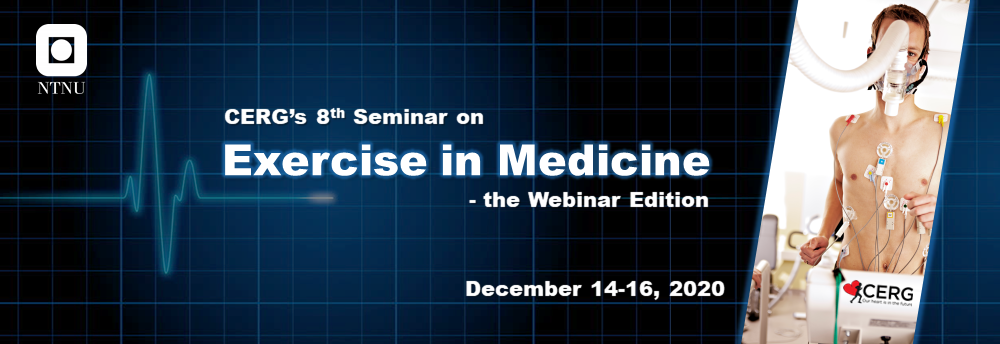Exercise advice - CERG
Exercise advice and exercise programs from CERG
Watch our video and learn how to perform 4x4-minute intervals in the best possible way. Then try our popular 7-week exercise program. On this page we have gathered some general exercise advice, in addition to our own simple and very time-efficient exercise programs.
4x4 interval training
We often use high-intensity interval training in our research, and recommend 4x4-minutes interval training to improve fitness. In this video, our researcher Anja Bye explains how and why you should perform this type of exercise.
Exercise for older adults
The Generation 100 Study is the world's largest study to look specifically at how older adults should exercise to get the greatest health benefits. As shown in this video, the main results suggest that also elderly should perform high-intensity interval training.
Ulrik answered anything
On November 27 2017, head of CERG, Professor Ulrik Wisløff, hosted a session for the Reddit Science Ask Me Anything series. Read all of his answers to find out everything you need to know about effective exercise for a healthy life.
Get fit for summer
TEDx Trondheim: High-intensity physical exercise will boost your health
Our researcher Øivind Rognmo discusses research on high-intensity physical exercise and its significant health benefits in this TEDx Talk from 2014. TED is a nonprofit worldwide community devoted to spreading ideas, usually in the form of short, powerful talks, and their TEDx program consists of local, self-organized events.
Frequently Asked Questions
Question: I often do 4x4 intervals while running, and stay at around 85–90% of my maximum heart rate (in the later intervals I reach this quickly). It feels right, and the lactic acid build-up doesn't hinder my next set of intervals. I've heard some people claim you should run at 95–100% during the last set, but others think acid build-up only is detrimental. What do you think? What would be the pros and cons of hitting 100% versus "only" 90% in the last set?
Answer: It is not damaging to run at 95–100% in the last interval, but it can be discouraging, making it harder to keep exercising in the long run. The benefit is practically negligible compared to staying at 90%.
Question: If I run four intervals, should I be completely exhausted after every interval and rather take a longer break between intervals, or is it better to not exhaust myself during the first couple intervals, and only take a two to three minute break?
Answer: You should feel capable of doing another interval after you've completed the four – if this seems impossible, you're too exhausted. For the sake of maintaining motivation, you should be equally tired after every interval – if you're going to exhaust yourself, at least wait until the last rep. Otherwise, most people get such a high lactic acid build-up that they are unable to reach optimal training intensity during the remaining intervals.
Question: About 7–8 years ago I had a stent inserted in a coronary artery after a small infarction. Therefore, I'm a little reluctant to start exercising. Is the 4x4-method appropriate for people like me? How would I start training? I feel like little attention and inadequate information has been provided to people like me.
Answer: Your experience is common, and it's a shame that the health authorities don't have a better system for people like you. Many of those who come to us are concerned, but learn that exercise isn't dangerous after we guide them through a training session.
Many associate interval training with running until they drop, but this is definitely not how it should be. We have positive experience with 4x4 interval training for people with coronary artery disease. However, every patient is different, and if you're unsure you should contact your doctor and get referred to a hospital where you can do an exercise test. That way, you'll get your answer from very competent people.
Question: I absolutely love 4x4 intervals, but am confused about heart rates. I often read or hear that you shouldn't exceed 70–75 % of your maximum heart rate, even during interval training. I find that really difficult, since I reach 80 % really quickly. If I'm supposed to stay around 70 %, I practically have to walk, which I don't find particularly strenuous. Yesterday, when I had finished 4x4, my average heart rate was 90 %, and no lactic acid build-up. Is this normal? I really prefer running my intervals at 90–95% of maximum heart rate. Will this help me progress? Am I getting into better shape?
Answer: Never exceeding 70–75% is a bad advice. If you're keeping your intensity that low, there's no need for intervals – you can probably keep it up for hours. And if you had no acid build-up at 90%, that's probably not actually 90% – unless you're in great shape. We recommend that you actually test your maximum heart rate:
- Warm up thoroughly so you start sweating.
- Do two intervals, each four minutes long. During the intervals you should be too short of breath. Walk slowly for three minutes between the intervals.
- Start the third interval, but two minutes in, run as fast as you can until you're too exhausted to continue. Your maximum heart ratae will be the highest heart rate you reach.
Question: During four-minute intervals I have no problem staying at around 180–190 bpm (I'm 33 years old). Between the intervals I try to calm down, but even when jogging very slowly I find it hard to get under 130–140 before the next four-minute run. Should I walk between intervals to get my heart rate down? And how low should it ideally go?
Answer: It sounds like what you're doing is perfect – your maximum heart rate i probably around 200 beats per minute if you're at 170–180 during interval training. That makes 140 beats per minute just right during the breaks, since you remove lactate most efficiently at 70 % of your maximum heart rate. Keep up the good work!
Question: I feel like I can control my workout better if I do it on a treadmill and can program inclines and speed. Recently I've only been running outdoors. Should I be running uphill? When is the right time to reach the desired intensity – should I be at 90 % after 20 seconds, or is it enough if I reach it by the last two minutes?
Answer: It's easier not to "cheat" on a treadmill, since you've programmed the speed and inclination. Reaching a high pulse uphill is easier, since you mobilize more muscles (unless you're a very good runner). Uphill running also prevents damage to muscles and joints.
A lot of people wonder about intensity. We're happy as long as you reach 90 % of your maximum heart rate during the first four min interval. During the rest of the intervals, it should take 1–2 minutes to reach the correct intensity.
Question: When I do 4x4 intervals, my trainer tells me to stay at roughly 70 % between reps, and 85–95 % during them. However, it seems like people define 0 % of maximum heart rate differently. Some people say that 0 % is your resting heart rate, while others say that 0 % is actually zero. At high intensity, this makes little to no difference, but at 70 %, it can really matter quite a lot. Which is correct? Personally, I feel using the resting heart rate makes most sense, because that seems like zero effort to me.
Answer: It is correct that you ideally should be at around 70 % of maximum heart rate during breaks. The reason is that you remove lactate most efficiently at that intensity. There are many ways to define exercise intensity, but during the active breaks you should stay at 70 % of your actual maximum heart rate, regardless of your resting heart rate. For instance, 70 % of 200 is 140. If you start including the resting heart rate the scale would be completely different, and it would become too complicated for most people.
Question: Does 4x4 interval training burn fat?
Answer: A common question has been whether you should run or walk in order to burn as much fat as possible. Put differently, what is better: high- or low-intensity exercise? The background for this question is that during low-intensity muscular work (30–40 % of maximum oxygen uptake), the metabolism of fat comprises roughly half the total energy, while less than 30 % of the energy comes from fat during high-intensity physical activity like interval training. This has led to claims that you should do low-intensity exercise if the goal is to burn as much fat as possible.
However, these claims are based on a misunderstanding. In reality, it is the total energy spent that matters, not the percentage of energy spent from fat. During high-intensity exercise, the energy expenditure per unit of time is greater. Thus, more fat is metabolized compared to low-intensity exercise, even if the percentage of energy from carbohydrate is greater.
Question: How many times a week do I have to work out in order to improve my current shape? I currently work out approximately 30 minutes every day.
Answer: Half an hour seven days a week is great! However, it is important to note that you get a significant health benefit with less exercise too, as long as the intensity is high. The official recommendations state that you could do 75 minutes of high-intensity physical activity each week, as an alternative to more frequent and longer moderate-intensity workouts. Past studies have also shown that if the intensity of an activity is high, one to two workouts a week can lead to significant health benefits.
Question: I exercise according to your regimen, and my question is how often would you recommend that I do interval training? Can I do it every day, or should I limit the frequency to protect my heart? How many times a week would you recommend?
Answer: Generally speaking, it looks like one session of interval training each week is enough to maintain your current fitness, and a greater frequency is required to improve your physical fitness. If the goal is to increase your physical fitness, we recommend 2–3 sessions with interval training per week. We don't know the optimal number of training sessions, and it may vary from person to person.
In one of our studies, test subjects did 5–8 interval training sessions every week. They found it tough to keep up motivation. Moreover, we found that the people doing intervals around eight times a week didn't get the desired physical adaptations, probably because of overreaching.
Question: A couple years ago, I experienced a heart fibrillation. Since then, I haven't dared to push myself to high heart rates of fear that my heart will start to flutter. Are my fears unwarranted? Can people with heart flutters exercise heavily, or should they keep their heart rates low?
Answer: That's a good question, and currently there is no clear answer. I presume it was an atrial fibrillation, which is uncomfortable, but not normally dangerous. Jostein Grimsmo from Feiringklinikken has shown that after being active for many years, endurance athletes have increased occurrence of atrial fibrillation. However, they also have increased longevity.
We actually don't know the effects of exercise in less well-trained people with atrial fibrillation, but are conducting a study to learn more. The results indicate that the incidence of atrial fibrillation decreases in this group when they exercise. Our recommendation is that you should talk to your doctor, and possibly get a referral to a work-ECG at a hospital to find out what you should do.
Question: I watched a program on TV about teenagers losing weight in a research study from the Faculty of Medicine and Health Sciences at NTNU. They had done interval training. How did they exercise?
Answer: We included very obese teenagers who were referred to St. Olav's Hospital due to their obesity. The test subjects were randomly placed in an exercise group or a control group.
Interval training with an intensity of 85–95 % of the maximum heart rate appears to give the optimal fitness effect. We found the individual heart rate goals for each teenager after we had determined their maximum physical capacity. They exercised on treadmills twice a week for 12 weeks under professional supervision while wearing heart rate monitors to ensure that the intensity was correct.
The exercise program consisted of a 10-minute warm-up at 60–70 % of maximum heart rate, followed by 4x4-minute intervals at 85–95 %. There was 3-minute active breaks at 60–70 % of maximum heart rate between each interval, and the session ended with a 5-minute cool-down at 60-70% of maximum heart rate.
After these 12 weeks of exercise, we let the teenagers take more personal responsibility, exercising at home or at a gym. They were advised to keep their routine of two or three weekly interval training sessions. They returned for check-ups one or two times each month the next year.
Question: Is it dangerous for pregnant women to do 4x4 interval training? Is there scientific evidence of a maximum pulse one should reach, after which there is damage to the foetus?
Answer: According to international guidelines, exercise with moderate intensity is safe during pregnancy. Not much research has been done on interval training or high-intensity exercise during pregnancy, but it looks like pregnant women are fine exercising up to 90% of maximum heart rate.
Answer: Many people think sit-ups are necessary to get fit. Rather, for most people it's more about burning more calories than they consume. That's the way to get rid of that extra fat. Try the 4x4 program and you'll feel the difference!
Question: Can seniors also do strength training like younger people?
Answer: Generally speaking, seniors can exercise just like younger people. Equally heavy and equally hard. All evidence indicates that the elderly benefit just as much from exercise as younger people, and it's never too late to start. Many seniors are limited by a lack of muscle mass, and would benefit greatly from strength training.
We recommend muscle-building strength training. Start with so heavy weights that you only manage 8-12 repetitions. Initially, one set of 8-12 reps is enough, but as you get stronger, increasing to 2-3 sets is good. And add more load as you get stronger.
Send us an e-mail:
cerg-post@mh.ntnu.no
Send us regular mail:
NTNU, Fakultet for medisin og helsevitenskap
Institutt for sirkulasjon og bildediagnostikk
Postboks 8905
7491 Trondheim
Visit us:
St. Olavs Hospital
Prinsesse Kristinas gt. 3
Akutten og Hjerte-lunge-senteret, 3. etg.
7006 Trondheim









